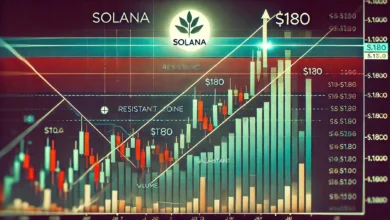Bitcoin ETFs See $1.23B Outflows as BTC Tests $107K Support
US spot Bitcoin ETFs experienced $1.23 billion in outflows between Oct. 13–17, signaling waning institutional demand. Analysts warn Bitcoin may break key $107K–$108K support amid tariff-induced volatility.

The crypto market is once again showing signs of turbulence, with Bitcoin’s price hovering precariously near a critical support level amid significant ETF outflows. According to Farside data, US-based spot Bitcoin ETFs recorded approximately $1.23 billion in net withdrawals between October 13 and 17. This persistent outflow suggests a waning appetite among institutional investors to buy into the recent dip, signaling a possible period of extended consolidation or even deeper correction ahead.
ETF Outflows Indicate Institutional Caution
The recent wave of withdrawals highlights a significant shift in institutional sentiment. The week saw several consecutive trading sessions of net outflows, broken only by a brief inflow midweek that wasn’t enough to offset the broader redemptions. This pattern indicates that institutions are adopting a risk-off stance following the latest market downturn and heightened macroeconomic uncertainty.
Analysts interpret these movements as evidence that major players are stepping back from aggressive accumulation strategies. When spot ETFs fail to absorb selling pressure, Bitcoin’s price becomes more vulnerable to sharp fluctuations. Historically, similar episodes of ETF outflows have preceded deeper retracements or prolonged sideways trading phases, particularly when macro conditions remain unfavorable.
Bitcoin Price Nears a Critical Juncture
As of this writing, Bitcoin is trading around $109,239, after briefly climbing above $113,000 earlier in the week before swiftly retracing below $110,000. This price action has brought the asset dangerously close to the $107,000–$108,000 support range—a level analysts describe as pivotal for maintaining short-term market structure.
Should Bitcoin break decisively below this zone, it could signal the start of a more extended consolidation phase or even a slide toward lower technical support levels. Market observers note that renewed buying interest from institutional investors—visible through sustained ETF inflows—will likely be required to stabilize prices and rebuild bullish momentum. Until that happens, rallies toward $112,000–$115,000 are expected to face consistent resistance.
Tariff Shocks Add Macro Pressure
The current weakness in Bitcoin and other risk assets is being compounded by macroeconomic uncertainty, particularly the renewed focus on US tariff policy. President Donald Trump’s recent tariff decision earlier this month has rattled global markets, prompting investors to adopt defensive strategies across equities and digital assets alike.
Tariffs and trade restrictions can lead to higher inflation expectations and tighter financial conditions, both of which weigh on speculative markets. In this environment, liquidity becomes scarcer, and institutional investors tend to scale back risk exposure. As a result, the combination of heavy ETF redemptions and macro-driven volatility is keeping Bitcoin’s recovery prospects muted in the near term.
A Flood of Pending Crypto ETP Filings
While short-term sentiment appears fragile, the broader investment landscape for digital assets continues to evolve rapidly. Industry data suggests that more than 150 exchange-traded products (ETPs) are currently awaiting regulatory approval, marking one of the most significant waves of crypto fund applications to date. Analysts predict that over 200 new crypto-linked funds—spanning approximately 35 digital assets—could enter the market in the next year once regulators give the green light.

Bloomberg ETF analyst Eric Balchunas described the phenomenon as a “total land rush,” reflecting asset managers’ eagerness to establish a foothold in the digital asset space through regulated instruments. Bitcoin and Solana lead the pack with 23 filings each, followed closely by Ethereum with 16 and XRP with 20. Litecoin, Polkadot, Avalanche, and Dogecoin also feature prominently, alongside more unconventional proposals such as ETFs linked to the “Official TRUMP” token and other meme-based assets.
These filings illustrate the growing mainstream integration of crypto assets into traditional finance. However, regulatory delays continue to hinder progress, and approval timelines remain uncertain. Once the pending products begin to launch, they could inject renewed institutional interest into the market, diversifying demand beyond Bitcoin and potentially stabilizing overall crypto liquidity.
What Lies Ahead for Bitcoin
The coming weeks will be crucial in determining the short-term direction of Bitcoin ETFs See. Analysts are closely monitoring ETF flow data, with particular focus on whether institutional capital begins to re-enter the market. A shift from sustained outflows to consistent inflows could signal renewed confidence and help Bitcoin reclaim lost ground. Conversely, continued redemptions may reinforce bearish sentiment and push prices lower.
Macroeconomic developments will also play a decisive role. Any additional tariff announcements or broader financial tightening measures could further pressure risk assets. Meanwhile, clarity on regulatory approvals for upcoming crypto ETPs could act as a positive catalyst if market participants view them as signs of institutional expansion and validation.
At present, Bitcoin remains at a critical tipping point. The $107,000–$108,000 support zone has become the market’s key battleground—its defense may preserve the broader uptrend, while a breakdown could trigger an extended consolidation phase. With institutional demand subdued and macro uncertainty intensifying, traders and investors alike are watching closely to see whether the world’s largest cryptocurrency can hold its ground.
FAQs
Q: Why is the Bitcoin market experiencing turbulence right now?
The market is volatile due to heavy institutional withdrawals from U.S.-based spot Bitcoin ETFs—totaling approximately $1.23 billion between October 13 and 17. These outflows reflect reduced institutional demand, increasing downward pressure on prices, and weakening investor confidence.
Q: What do ETF outflows indicate about investor sentiment?
ETF outflows signal institutional caution. Large investors are reducing exposure amid macroeconomic uncertainty, suggesting a risk-off sentiment. Historically, such outflows have preceded price consolidations or deeper corrections in Bitcoin.
Q: What is Bitcoin’s current price situation?
As of now, Bitcoin is trading near $109,239, hovering close to a critical support zone between $107,000–$108,000. If this support breaks, analysts warn of an extended consolidation phase or even a deeper slide to lower technical levels.
Q: What are analysts watching for next?
Analysts are closely monitoring ETF inflows and outflows. A shift back to inflows could indicate renewed institutional confidence and help Bitcoin reclaim ground. Continued redemptions, however, may confirm sustained bearish sentiment.
Q: How are US tariffs influencing the crypto market?
President Trump’s recent tariff decisions have added pressure on global markets, contributing to risk aversion. Tariffs can increase inflation expectations and tighten liquidity—conditions that typically hurt speculative assets like cryptocurrencies.
Also More: Bitcoin Braces for a Critical Week Amid Tariff Jitters & Altcoin Catalysts









